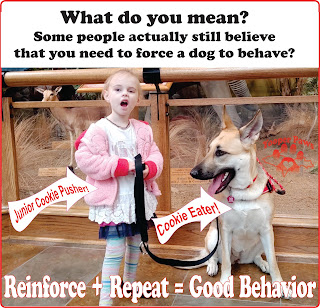Reinforce + Repeat = Good Behavior!
I decided to pull in this blast from the past to address today's myth and discuss using food treats as reinforcement for good behavior! This picture shows my granddaughter several years ago as she was learning how to use treats as reinforcement with my first Service Dog.Myth: You have to show the dog you are boss if you want them to listen to you!
If that were true, our dogs would not work for children! And quite frankly, they wouldn't work for lots of people in general who are softer voiced with passive mannerisms. I don't want my dogs doing things because they think they have to in order to please me. Instead I want them to choose the behaviors they know will please me because that choice will lead to great things happening. I'm not going to debate this highly debate triggering topic in this blog because it would be totally one-sided. But I'm happy to show you the science behind positive reinforcement training if want to see it.
Instead I want to talk a little bit about being a "Cookie Pusher!" This seems to be a common topic that some people look at using treats as reinforcement as a great thing while others would rather not use treats as reinforcement. If you check out the February posts on Reinforcement, linked here, you can see how I use lots of different reinforcement methods in training. So today I'm going to focus on how I use food reinforcement for various types of training.
Training New Skills
The #1 reason so many dog trainers use treats during training sessions is that it is easiest for humans to use quickly and effectively to tell a dog when they are doing something right. When you are training something totally new, timing is everything! Being able to mark, reinforce, and repeat rapidly can make or break your training ability. Once your dog learns the behavior you can add in other forms of reinforcement, but food helps you get to that point.
Training Around Distractions
It's easy to use a wide variety of value in food reinforcement and adjust the value to be greater or equal to the distraction that presents itself. This is especially important when training in public environments! I like mix up a bag of Puppy Trail Mix before heading out to train at the local park, community event or pet friendly environments. Then I can use this Trail Mix while training Service Dog Public Access as well. (Directions for Trail Mix below!)
Training Around Fearful Distractions
If you're dog has a fearful response to practically anything (thunder, people, snakes...anything real or imagined!) you can use high value food reinforcement to carefully desensitize your dog to that fear, then countercondition them to believe that object is not so scary because it predicts great things are coming. This is a very challenging process, so if your dog is fearful you want to work with a Behavior Consultant to create a training plan to work on this correctly. Otherwise you can actually make your dog's fear worse if you attempt this incorrectly!
What treats do I use and how do I use them?
This is a question I get asked quite regularly! So I created this list of frequently used dog treats that my dogs like and reasons that I use them.
Puppy Trail Mix
Making trail mix is really easy! I use about 50% low value treats like kibble or small pieces of milkbones, 25% mid-value treats, and 25% high value treats. Of course I adjust those percentages based on the training I have planned. If I'm working a higher distraction environment or generalizing a fairly new behavior I want a higher value mix.To use the trail mix, is dependent on the training session. If I'm working on a concept such as checking in with me on a hike, I'm going to toss out variable treats of mixed value when my dog repeats the behavior I'm working on. This way the dog has no idea what treat they will earn which keeps them trying and offering the behavior frequently. If I'm not working on a specific concept by want to reinforce known behaviors, I'm going to use the lower value treats to reinforce easy behaviors and pick out the higher value for more difficult behaviors or newer behaviors.
All of my training clients know that my treat bag is typically filled with a variety of treats. This is especially important with picky eaters or working with multiple dogs as a treat that is low value to one dog might be high value to another dog.
I hope this post helps you to learn to use your "Cookies!" more effectively in training sessions!



.png)



No comments:
Post a Comment